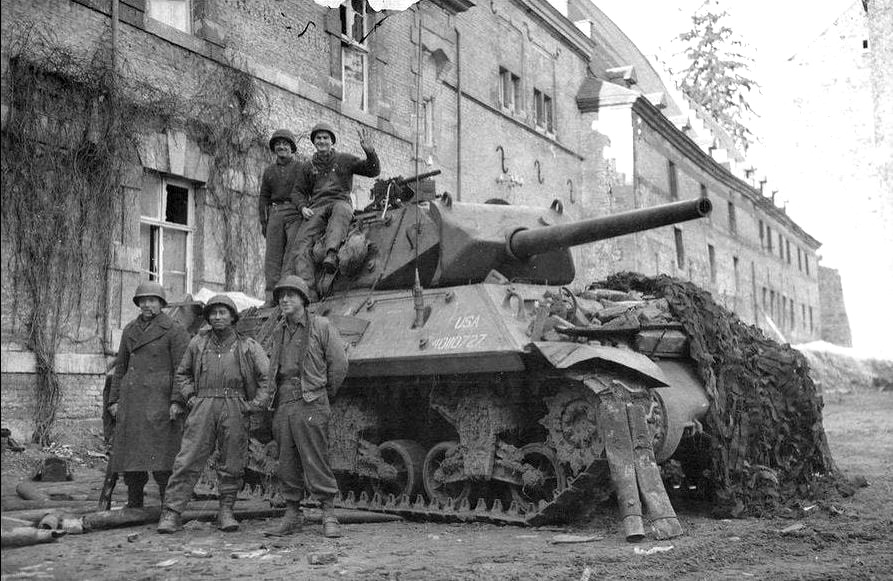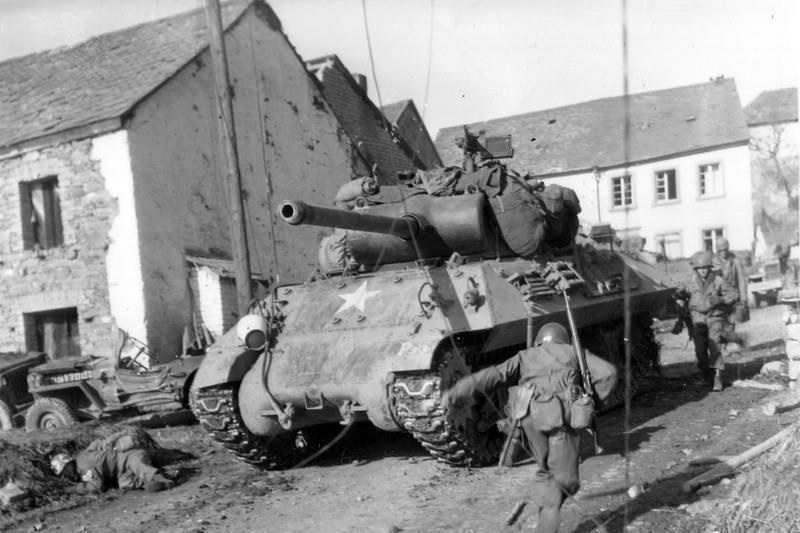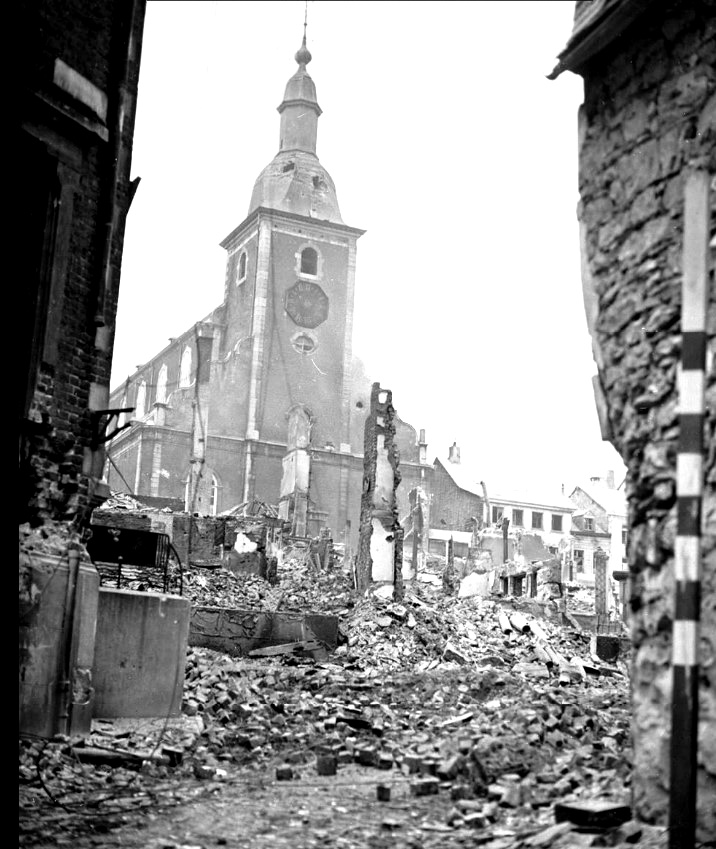Document Source: File #847-59, After Action Report, 825th Tank Destroyer Battalion, September 1944 – October 1944 & Able Company 825-TDB December 17 1944 to January 17, 1945. Archives Collection European Center of Military History.

 On September 1944, the 825th TD Battalion had nearly completed a mission assigned to it by Headquarters, Advance Section, Communications Zone. In the accomplishment of its mission during the month of August, the battalion had been scattered lengthwise and over the entire width of the Cotentin Peninsula from Cherbourg to La Haye-Pesnel; then east to the vicinity of Le Mans. Now with it Headquarters and Headquarters Company at the treasure-filled Richelieu Estate, Château du Haut-Buisson near Cherré with Able Co at Alençon, Baker Co at Mayet and Charlie Co at Beaumont, the job was almost finished. On September 4, the battalion marched by sundry routes to a bivouac area approximately four miles west of Sens where it immediately inaugurated a program of maintenance, cleanup, and resupply.
On September 1944, the 825th TD Battalion had nearly completed a mission assigned to it by Headquarters, Advance Section, Communications Zone. In the accomplishment of its mission during the month of August, the battalion had been scattered lengthwise and over the entire width of the Cotentin Peninsula from Cherbourg to La Haye-Pesnel; then east to the vicinity of Le Mans. Now with it Headquarters and Headquarters Company at the treasure-filled Richelieu Estate, Château du Haut-Buisson near Cherré with Able Co at Alençon, Baker Co at Mayet and Charlie Co at Beaumont, the job was almost finished. On September 4, the battalion marched by sundry routes to a bivouac area approximately four miles west of Sens where it immediately inaugurated a program of maintenance, cleanup, and resupply.
Able Co was detached from the battalion on or about September 9, to serve with the T Force of the 12th Army Group. Reporting at T Force Headquarters Verdun, for more detailed instruction, Capt Joseph R. Dibert, Able 825-TDB’s CO, on September 11, was called upon to employ his first platoon at Metz and his second platoon at Nancy. On September 13, the remainder of his Company moved to and established its Headquarters in Luxembourg later being joined by the first and second platoons.
Sgt Joseph Salvetti (#21130116), was wounded by shrapnel near Metz and was Able 825-TDBs only casualty of the month. The battalion is less Able Co executed a blackout march on the night of September 14 arriving at Verdun on or about September 15 where it was relieved of assignment to the US 3-A and assigned to the 12th Army Group with the mission of furnishing perimeter defense of the 12-AG installation and personal protection for the Group Commander during his inspection of the front with visiting dignitaries. On September 22, the third platoon, Charlie Co was detached from its company and the battalion and assigned the mission of providing security for the 12-AG signal installations in the vicinity of Arlon (Belgium).
For the Commanding Officer
Roger D. Fee
Capt, 825th TD Bn
Adjutant
October 1944
During the month of October, the 825-TDB extended itself over an even wider area of operation employing its troops simultaneously in Luxembourg, in France, and in Belgium. On October 14, after six weeks of bivouacking, the battalion (less detached units) marched with Headquarters, 12-AG TAC from Verdun to Luxembourg and moved indoors.
On October 9, Able 825-TDB and Headquarters T Force moved from Luxembourg to Spa (Belgium). Because of intense V-1 activity in the vicinity of Aachen, on October 21, they shifted approximately fifteen miles west of La Reid (Belgium) where spotters were established at points of vantage. With instruments, these spotters have since been plotting V-1 to its points of origin.
Security of the 12-AG signal installations was a priority mission and scattered detached units on a schedule best shown as follows:
Date – Unit – lace – Remarks
Oct 2, 1944 – 2nd Platoon, Charlie Co – Vicinity of Nancy – None
Oct 7, 1944 – 1st Recon Plat. Hq Co – Luxembourg – None
Oct 14, 1944 – 3rd Platoon Charlie Co – Gerval-Bresil – Relieved of similar mission at Arlon (Belgium)
Oct 18, 1944 – 3rd Platoon Baker Co – Verdun & Nancy – One section at Verdun; one section at Nancy; relieving 2nd Platoon Charlie Co from Nancy to Battalion Control
Oct 20, 1944 – 2nd Sec, 1st Plat, Baker Co – Cour (Belgium) – None
Oct 22, 1944 – 1st Sec, 1st Plat, Baker Co – Odeigne (Belgium) – None
Oct 22, 1944 – 1st Sec, 2nd Plat, Baker Co – Gravels (Luxembourg) – One squad of this section was reassigned to Luxembourg
In Luxembourg a shelling by heavy German Artillery (thought to be a 280-MM railway gun) began at about 0130, October 28, 1944, provided the month’s most interesting news item but caused no casualties among military personnel.
Able Co – 825-TDB
After Action Report
December 17, 1944 – December 21, 1944.
Maps: Germany, 1/25.000, Malmedy, sheet 5502, France and Belgium, 1/25.000, Stavelot, sheet 81, (South)
The company was alerted by Hqs T Force 12-AG at 1130 hours on December 17, 1944. At approximately 1600 hours, orders were received from T Force Commander that the Provost Marshall of First Army directed the Company move to Malmedy (Belgium) and occupy firing positions east of town. The Company was to be attached to the 526th Armored Infantry Battalion for the move to Malmedy. Upon reaching Malmedy, the CO was to report to Col Harold D. Hansen, Commander of the 99th Infantry Battalion (S). The company joined the 526-AIB and passed the IP at La Reid (Belgium), at 2200 hours on this date.
While en route to Malmedy, the column was ordered to halt and await further instructions. Written orders were received that one Company of the 526-AIB and one Platoon of Able Co 825-TDB should move to Stavelot (Belgium), and occupy positions south and southeast of the town whereby the roadblocks already established could be covered by fire. The force was placed under the command of Maj Sollis, Executive Officer 526-AIB, and was made up of Able 526-AIB, and 1st Platoon, Able 825-TDB. This force moved to Stavelot and the remainder of the column moved to Malmedy. The column arrived at Malmedy at 0200 hours, December 18, 1944.
I reported to Col Hansen (99-IB) as ordered upon arrival; who ordered my company to occupy positions already chosen to cover the roadblocks by fire. Guides were furnished by Charlie Co, 291st Engineer Combat Battalion and Platoon Leaders moved guns into position. The 3rd Platoon took up positions in the vicinity of the roadblock at (803036). The 2nd Platoon took up positions in the vicinity of roadblocks at (792052) and (778037). One section of this platoon occupies positions at each location. The defense was set up and guns in position at 0430 hours on this date.
The 1st Platoon arrived at Stavelot at approximately 0330 hours, December 18, 1944. Mazj Solis, the force commander, sent one Platoon of Able 526-AIB and one section of this unit, across the Amblève River to occupy positions on the high ground south of town. The other section of the 1st Platoon and the AT Platoon of Able 526-AIB were held in reserve. The 1st Section crossed the river at approximately 0605 hours on this date. This Section was unable to reach the positions designated due to enemy fire and upon trying to withdraw to take up positions to return enemy fire, they were hit by direct fire from the enemy, knocking out the two guns and half-tracks. As a result of this action, six EM were missing and two were battle casualties. At daylight, the enemy placed considerable fire on the town of Stavelot. The fire was coming from machine guns and heavy weapons which were set up in the houses overlooking the town. One gun was put in position at (721013) whereby fire could be placed on the fixed enemy positions. By 0930 hours, the gun had set fire to six houses and hit approximately ten others. At 1000 hours, the rumble of tanks could be heard and the tanks appeared on the hill south of the town.
Four German Mark VI-2 King Tigers tanks were observed, and taken under fire by the Section which remained inside Stavelot. Each squad knocked out two tanks. A fifth Mark VI-2 KT had come into town by another route and could be heard reconnoitering the town by fire. A gun was moved to a position in the center of the street at (719012) so as to permit firing on the approaching tanks. Some 15 rounds were exchanged in the firefight. One of the rounds from the 3″ gun hit one tank at a point where the barrel extends from the turret, and the tank withdrew. In doing so, the tank backed into a brick building and pulled the building down pinning the tank underneath the wreckage. During this action, the platoon leader received an order to withdraw, but due to the enemy fire, it was impossible. However, at 1145 hours the remainder of the platoon withdrew under covering fire which came from the gun located at (719012). The gun commander and gunner, firing the gun at (719012) after making certain the platoon had withdrawn, rendered the gun useless to the enemy by placing an M-14 TH incendiary hand grenade in the breach. The two non-commissioned officers then withdrew on foot. One 1/4-ton truck and one half-track were lost during this action and one man was wounded.
On December 19, 1944, two men of the company captured three suspected German soldiers in civilian clothes in Malmedy and turned them over to CIC (Counter Intelligence Corps). The 3rd Platoon received enemy mortar and small arms fire in their position. No casualties for the period. On December 20, 1944, gun positions were improved. No contact with the enemy during this period.
An attack by the enemy was expected and all personnel was alerted at 0300 hours on December 21, 1944. At approximately 0700 hours one section of the 2nd Platoon located at (778037) made contact with the enemy and destroyed one 1/4 truck, one half-track, and one another Mark VI-2 KT Tank. In addition, the section at (778037) inflicted heavy casualties on the enemy. During this engagement, two men were battle casualties, and two were wounded but not hospitalized. One 3″ gun was knocked out. In this same operation, the section captured one M-8 and two 1/4-ton trucks (American; in serviceable condition, which were used by the enemy. Baker 99-IB also engaged the enemy at this point.
During the period from December 23 to December 28, 1944, platoons remained in defensive positions and continued to dig in and improve positions. On December 24, the 3″ gun and half-track of the 3rd Squad, 1st Platoon, was repaired and put into position at 2000 hours at (778038). This gun supported one gun of the 2nd Platoon located at (778036). On December 25, 1944, positions remained the same, and the 3″ gun and half-track of the 4th Squad, 1st Platoon, was recovered from Stavelot. On December 26, 1944, this gun and half-track were repaired and put in position at 2000 hours at (778039). All other positions remained the same. All positions remained the same during the period from December 28 to December 28, 1944, included.
On December 29, 1944, one reconnaissance was made for the location of new and better positions. The 2nd Section, 3rd Platoon moved to and occupied the new positions at (804039) the other section remained in position at (797039) the other section remained in position at (797039). Further reconnaissance was made for positions on December 30, 1944, and the 1st Section, 3rd Platoon moved to and occupied new positions at (803041).
Joseph H. Dibert
Capt, 825th TD Bn
Commanding, Able Co
























